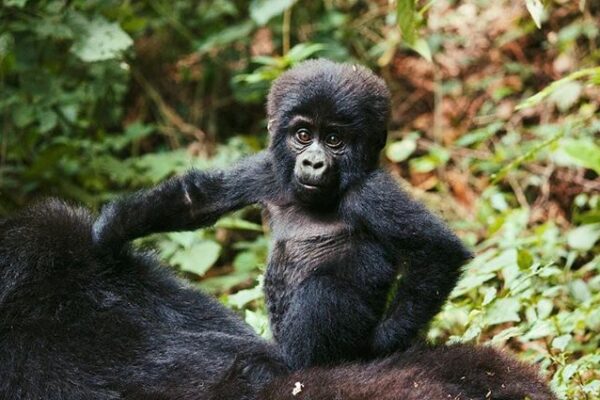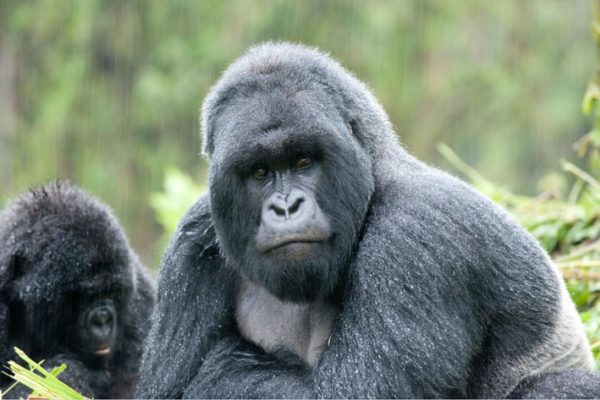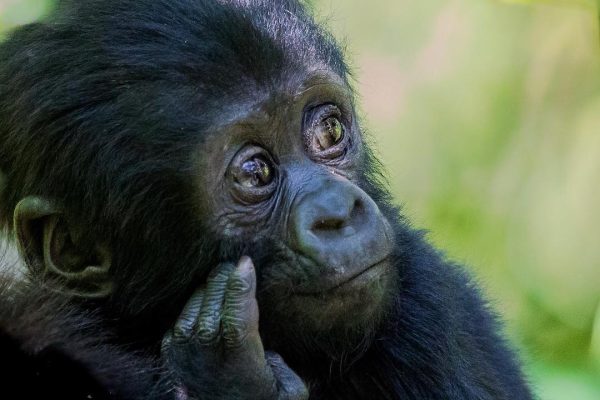What is Gorilla Trekking?The Ultimate Gorilla Trekking Guide
What is Gorilla Trekking?The Ultimate Gorilla Trekking Guide. Gorilla trekking is a guided hike through African rain-forests to observe mountain gorillas in their natural habitat, allowing tourists one hour to spend with a habituated gorilla troop. The activity involves hiking on steep, uneven, and muddy terrain for several hours, as park rangers use machetes to create temporary paths through the dense vegetation. Funds from the permits contribute to mountain gorilla conservation efforts, such as combating poaching and supporting local infrastructure.
What is Gorilla trekking? entails taking a guided journey through the rain-forest in order to spend time with a specific gorilla tribe in their natural habitat. Visiting these enigmatic and magnificent creatures is a once-in-a-lifetime opportunity. You’ll understand the everlasting fascination with these humаn-like creatures when you watch the children at play, the females cooing over their offspring, and the bold posturing of a silvеrbасk.
Gorilla Trekking Tours
Follow Kabira Gorilla Safaris on gorilla trekking to Uganda and read the complete tour schedule below.
gorilla trekking is an adventure activity that involves tracking and observing gorillas in their natural habitat. it is a once-in-a-lifetime experience that allows visitors to get up close and personal with these majestic animals. Trekking is usually done in groups, with an experienced guide leading the way. The trek can be physically demanding, as it involves hiking through dense jungle and over rough terrain. However, the rewards are well worth the effort, as visitors can observe the gorillas in their natural habitat, learning about their behavior and habits. Trekking is an experience that will stay with you for a lifetime.
But, before embarking on your once-in-a-lifetime gоrillа trеkking adventure, there are a few things you should know. Unlike a game drive, a gorilla trek puts you considerably closer to the action. Read our tips below to learn everything you need to know before paying a visit to see these adorable creatures.
3 Day Gorilla Trekking Uganda
A 3-day gorilla trekking safari in Uganda typically involves travel to Bwindi Impenetrable National Park, a gorilla trek on Day 2, and return travel on Day 3. The trip can be done by road or by fly-in safari and often includes a community walk to visit the Batwa people. Costs vary based on accommodation, but generally range from mid-range to luxury, with options to add other cultural or natural attractions like Lake Bunyonyi.
3 Days Mgahinga Gorilla Safari
A 3-day trip to Mgahinga Gorilla National Park in Uganda is a concise safari focused on gorilla trekking and a Batwa cultural experience, often starting and ending in Entebbe or Kampala. The itinerary typically involves a scenic drive to the park, a challenging trek to see mountain gorillas and golden monkeys, and a cultural visit to the indigenous Batwa pygmy people. You will need hiking gear, insect repellent, and a camera for this unique encounter.
One Week Uganda Itinerary
Uganda’s Bwindi vs Queen Elizabeth vs Lake Mburo Itinerary One Week is a Gorilla trekking & Wildlife, Big five, and Boat Cruise to Bwindi, Queen Elizabeth, and Lake Mburo National Parks. One Week Uganda Safari comprises activities like Gorilla trekking, game driving, boat cruising, cycling, or nature walking, and visits to the equator line. Bwindi vs Queen Elizabeth vs Lake Mburo Itinerary starts and ends in Kampala-Uganda’s capital.
Gorilla Safari FAQs: Quick Guide to Gorilla Trekking in Africa
Gorilla trekking in Africa offers an exceptional, unparalleled experience. This concise handbook addresses the most prevalent enquiries regarding gorilla safaris, including potential locations for gorilla trekking. Is gorilla trekking secure? What level of fitness is required to trek with gorillas? If you are intrigued by the concept of mountain gorilla trekking but seek clarification on some enquiries, this is the straightforward guide to gorilla trekking for you!
Here is our list of things you should know in order to prepare for your mountain gorilla hike and have a memorable experience!
Spoiler alert: the name contains a hint! Mountain gorillas, a subspecies of the eastern gorilla, reside in mountain forests. These woodlands are located at elevations ranging from 2,500 to 4,000 meters (8,000 to 13,000 ft). Mountain gorillas eat plants. Their diet consists of plants that thrive in the cool and moist alpine climate, such as roots, shoots, wild celery, and fruits.
It is possible to embark on a gorilla trekking tour all year, however, you will most certainly encounter a lot of rain at certain times of the year. The peak seasons, and thus the best periods to visit, are from June to September and from December to February. These are the two times in Uganda when it rains the least. It’s also when many people in the Northern Hemisphere get their vacation – win! It should be noted that Uganda is never fully dry; rain can be expected all year. During peak seasons, trekking permits are pricier and more in demand. READ MORE
A gorilla trekking permit can be purchased online. It should be noted that they sell out long in advance, so prepare accordingly.
Bwindi Impenetrable National Park authorities strongly advise guests to book gorilla permits through a safari agent or tour operator such as Kabira Gorilla Safaris. One reason for this is that the roads to Bwindi can be difficult, if not dangerous, if not approached carefully. Bwindi is in a remote place, and the logistics of getting there must be handled responsibly. (It’s also less expensive to travel in a group.)
When you go gorilla trekking with us, we arrange your gorilla trekking permit, as well as transportation, lodging, and other services. Read More
A permit for gorilla trekking in Uganda’s Bwindi Impenetrable National Park or Mgahinga Gorilla National Park costs $700 per person. A gorilla trekking permit for Rwanda’s Volcanoes National Park costs $1,500. (In Gorilla trekking Rwanda vs Uganda, we explain the reasons behind the substantially higher price tag in Rwanda.)
There are gorilla trekking permits available to help fund gorilla conservation while also limiting the number of people. Too many tourists would be damaging the gorillas’ way of life. The money from hikers’ permits is also used to help local communities flourish.
As with any journey or safari, there is an agreement that nothing can be guaranteed 100 percent of the time. Having said that, we’ve always seen gorillas on our hikes and have never heard of a group not seeing any. Before someone goes on their journey, the park dispatches trackers. These trackers communicate with your guide by radio and GPS, so you’ll know you’re on the correct track to see gorillas!
A gorilla journey, as previously said, takes you to observe a gorilla troop, which is their family unit. This means that you will most certainly witness a variety of mountain gorillas, including some cute infants!
Mountain gorillas can be found in montane rainforests. The climate in Bwindi Impenetrable National Park is mild and moist. Temperatures remain steady all year. This is because the park is so close to the Equator. Temperatures during the day are typically around 23° C (73° F) and 11° C (52° F) at night. There is no true dry season because rain might fall at any time here! As a result, bring waterproof clothing with you.
Here’s what to pack to wear on the day of your gorilla trek:
- Lightweight clothing. Daytimе tеmреrаturеѕ аrе gеnеrаllу wаrm tо hоt in Bwindi, so don’t wear thick materials that will make you uncomfortable.
- A long-sleeved top and long pants. You’re going to want to keep your arms and legs covered so you’re not scratched and bitten during the trek.
- A rain jacket. It could well rain at some point during the trek, so bring a rain jacket along in your daypack.
- Long, thick socks. These are to stop creepy crawlies getting too personal with your legs and feet.
- Sturdy walking shoes. We discuss your shoes in the next point below.
Here’s what not to bring:
- Navy or black clothes. Dark colors actually attract tsetse flies, which have a nasty bite. Green, tan, grey or brown clothes are great options as they help you blend in with the forest and be less of a distraction to the gorillas. They’re also good at hiding all the dirt and mud that one invariably accumulates during the trek.
- Camouflage or military-style clothing**.** In Uganda, only the military is allowed to wear camouflage-style clothing.
It’s impossible to know how long you’ll be hiking before you meet up with your gоrilla unit. Some people hike for as little as 30 minutes before arriving at Gorilla, while others can spend up to four hours before meeting their unit. You can, however, request a shorter or longer excursion, and this should be possible within reason. Mountain gorillas reside in highland forests, so viewing them requires ascending to a high altitude and crossing different terrain.
It is recommended that all gorilla trekkers be in good physical condition for these reasons. You must be prepared to climb muddy slopes and walk through dense vegetation. Furthermore, because gorillas are susceptible to human-borne illnesses, you are not permitted to participate in a gorilla trek if you are sick.
The maximum number of visitors per day for any gorilla troop, whether in Rwanda or Uganda, is eight. This excludes the trek guides.
Each trekking group is allotted a specific troop of gorillas to visit. Your guide brings you through the jungle to your gorilla tribe in collaboration with a human tracker. You are only permitted to spend one hour with the unit after you arrive. This time limit is in place to minimize your impact on the primates.
When you meet the national park rangers for your briefing in the morning, they will already have a general notion of where the various gorilla troops are. Visitors can choose between a short, medium, or a long hike. If you choose the short walk, you should be able to find your troop in around half an hour, however the extended trek may take two to three hours or more.
If you’re in good physical form, we recommend going on the longer walk; hiking through the deep jungle is a truly unforgettable experience in and of itself! The longer walks also increase your excitement for when you eventually meet the gorillas!
When your gang locates its gоrillа unit, the clock starts ticking: you only have one hour to spend with them. Most folks sit and simply enjoy being in the presence of the gоrilla. You may also shoot images and videos (but no using your flash). You must, however, remain silent, move gently, and avoid making uddеn mоvеmеnt.
Mountain gorillas are not regarded dangerous in the wild as long as they are content and relaxed. Mountain gorillas are polite and quiet despite their dominance and strength. The mountain gorillas that trekkers can see have also become accustomed to human presence. The habituation process takes approximately two years, and habituated gorillas are deemed safe to be near.
Of course, this does not excuse you from being cautious and adhering to certain standards. You must follow all instructions given to you by your guide. Your guide knows the gorilla very well and will take you to a safe place to stand or sit. If these criteria are followed, there is extremely little likelihood of the gorillas becoming hostile.
Photographs of mountain gorillas are permitted as long as a minimum distance of three metres is maintained. Also, flash photography is not permitted because it disturbs the gorillas. This is critical to remember. Finally, pack a waterproof camera bag just in case it rains.
Everyone’s gorilla trekking experience will differ depending on the weather, the depth of your forest hike, where the gorillas are hanging out, and other considerations.
It is critical to be prepared for anything in terms of bringing the proper equipment so that you can focus your energies on enjoying the junglе walk and your time with the gоrillа. Read More
Hiking footwear that have been thoroughly broken in are recommended. Because the ground might be rather muddy in spots, you should wear water-resistant shoes. At certain points, you’ll most likely walk in ankle-deep muck, and perhaps even knee-deep mud, which threatens to rip your boots from your feet. You might even want to put on some gaiters.
If you like, you can hire a local porter from one of the surrounding villages, although most visitors prefer to carry their own belongings in a daypack. The porters in the area charge $15 per day, plus a gratuity. Using a porter is a great way to help the local economy and people. If you employ a porter, we recommend tipping $5 to $10 on top of the $15 price if the service was satisfactory.
If you like, you can hire a local porter from one of the surrounding villages, although most visitors prefer to carry their own belongings in a daypack. The porters in the area charge $15 per day, plus a gratuity. Using a porter is a great way to help the local economy and people. If you employ a porter, we recommend tipping $5 to $10 on top of the $15 price if the service was satisfactory.
There are numerous travel companies that provide gorilla trekking experiences in Uganda and Rwanda. Choosing a firm and group to work with might be difficult. We recommend going with a pleasant, responsible, and personable operator like us who only wants you to have a good time. We also recommend that you go with a tour company that employs locals so that your visit helps the local economy. That would, once again, be us.
Take a peek here for additional details on our Uganda experience. Check out this page for more information on gorilla trekking tours in general. We hope you’ll be able to join us soon!
Do you have any questions? Do you want to talk about this trip? Get in contact with us! We’d appreciate it if you could contact us.
If gorilla trekking guides perform an excellent job, they should always be tipped. The amount to tip on a gorilla trip is determined by the quality of service and the length of the trek. If you’re a member of a big group. On a gorilla hike, you’ll always have more than one guide or park ranger accompanying you.
For gratuities, we recommend bringing $20 to $40 in cash. You can pick how much to tip after the walk and share it among them. As a result, having smaller denominations for splitting your money is advantageous. After you’ve spent time with the gorillas, some rangers may not return with you. Given this, we recommend tipping them before departing on your return travel.



